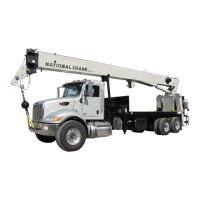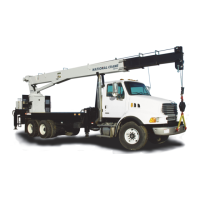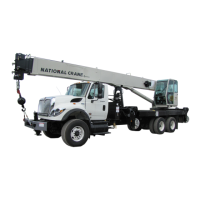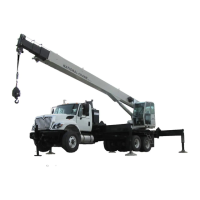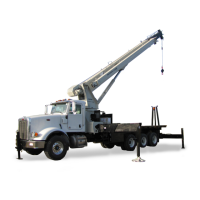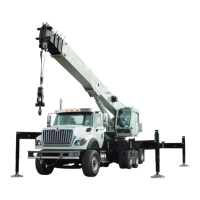National Crane Published 5-27-2018 Control # 039-06 2-9
800D OPERATION
If the operator cannot see the load handling device
approaching the boom nose, he shall have an assistant
(signal person) watch the load handling device. The operator
shall be prepared to stop the machine immediately should
the RCL (or optional HCA system) not function properly. If
the RCL (or optional HCA system) is not functioning properly,
lifting the anti-two-block weight will not activate the red
warning light or the audible alarm (optional for the HCA
system), and will not lock the crane movements hoist up,
telescope out, and boom down.
Check the anti-two-block alarm light and the audible alarm
by performing one of the following tests:
• Manually lift the weight attached to the anti-two- block
switches. When the weight is lifted, the audible alarm for
the RCL (or optional audible alarm for the optional HCA
system) should sound and the anti-two-block alarm light
should light.
• Slowly raise the main boom load handling device to
create a potential two-block condition. When the load
handling device lifts the weight, the audible alarm should
sound, the anti-two-block alarm light should light and the
motion of the load handling device should be stopped.
Lower the load handling device slightly to eliminate this
condition.
• Slowly extend (telescope) the boom to create a potential
two-block condition. When the load handling device lifts
the weight, the audible alarm should sound, the anti-two-
block alarm light should light and the boom telescope
out function should be stopped. Lower the load handling
device slightly to eliminate this condition.
If the light and audible alarm do not function as described
and the crane movements are not stopped, the system is not
working properly. The malfunction shall be corrected before
operating the crane.
• If the crane is equipped with a boom extension that is
deployed and rigged for work, repeat the test procedure
for the boom extension anti-two-block switch.
• Check that the display of the main boom length agrees
with the actual boom length.
• Check that the display of the main boom angle agrees
with the actual boom angles.
• Check that the display of the operating radius of the
crane agrees with the actual radius.
• Check the load display by lifting a load of known weight.
The accuracy of the load indication shall be within the
tolerance of SAE J159.
Operation
After being properly checked, the RCL is operational. The
operator shall be thoroughly familiar with all controls of the
RCL and he shall properly set the reeving (parts of line)
selector before operating the crane. The proper function of
the system shall be checked by lifting a load of known weight
and comparing the load to the information displayed on the
RCL.
Rated loads include the weight of the hook block, slings, and
auxiliary load handling devices. Their combined weights
shall be subtracted from the listed load capacities as stated
on the load capacity chart to obtain the net load to be lifted.
If any of the displays reflect a deviation between
displayed and actual values, an authorized PAT service
representative shall be called for repair of the system or
reverification of the crane’s RCL calibration.
Any structural modifications or changes to the crane
shall require reverification of the crane’s RCL
calibration.
The RCL will warn the operator when hoist and loadline
overload occurs but will allow the boom up function to
continue to operate. Booming up a hoist and loadline
overload in areas where the boom capacity exceeds the
loadline capacity can cause serious damage to the hoist
and loadline. Always reeve the loadline properly for the
load to be lifted.
WORK SITE POSITION
Always seek the best possible work site when parking the
crane. An ideal parking location at a job site is firm, level, dry
ground or pavement located in close proximity to the work
station. Avoid uneven, rocky or muddy terrain, steep grades
or locations with unnecessary overhead obstructions.
Location should be selected such that outriggers can be fully
extended and legs come down on firm level surface.
Particular care must be taken in selecting a site position to
the location of overhead power lines so that proper
clearance conditions can be maintained. Ideally, one should
select a location at which the boom could not come within
minimum recommended distance of the power lines at full
extension.
Fo
r
Reference
Only
